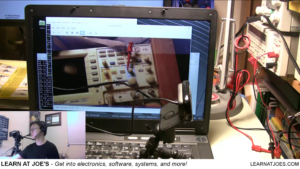Time-Lapse capture with webcam and Linux scripting.
Disclaimer: As an Amazon Associate I earn from qualifying purchases.
Time-lapse photography is a concept of taking snapshots at a particular interval over time to record events in a low resource manner, compared to capturing a video stream. Here, we discuss how to use a relatively inexpensive web camera and a computer to build a low-budget time-lapse platform.
Action Summary

Pretty much any relatively modern PC with decent storage and functional USB 2.0 ports should suffice. I had an old big-box special on hand.
Logitech webcams tend to plug-and-play easily with Linux distros:
The Logitech C615 is the model featured. It does 1080p capture, with some nudging.
*Even though I held up an external HDD in the footage, I didn’t get to show setting that up yet and instead relying on internal storage for now.
The “cheese” program is a quick way to test a webcam. (https://help.gnome.org/users/cheese/stable/introduction.html.en). To install on a Ubuntu/Mint system, use apt-get in a terminal window:
sudo apt-get install cheese
A Compact Flexible Tripod makes for camera positioning in tight corners.
We looked at how to use the fswebcam Command Line utility to capture images via the terminal. You may either git clone from the project page, or on an Ubuntu/Mint system, enter in a terminal window:
sudo apt-get install fswebcam
It is a bit of trial-and-error figuring the optimal parameters for the fswebcam utility with a camera.
Then we watched how bad I am at live shell scripting, though I freely admit its not my everyday gig and that I make liberal use of internet search the few times I write shell scripts. Can’t go wrong with an O’Reilly book on Shell Scripting if you want an at arms reach reference to thumb through
Hope you found this useful and informative. Having a setup like this opens up a lot of other potential applications to build upon.
Disclaimer: from a technical and functional perspective, this post is about using extending usage of commodity hardware using computer scripting. There are some potential premise security applications for such a setup. While anyone is welcome to use the information herein, the reader is responsible for determine appropriate for use, deployment, and maintenance of such applications for their security needs. I/We do not explicitly endorse this type of setup as a part of a security protocol.